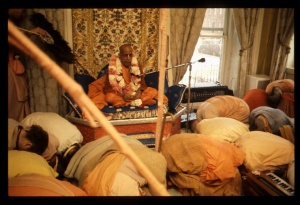CC Adi 7.103 (1975): Difference between revisions
(Vanibot #0027: CCMirror - Mirror CC's 1996 edition to form a basis for 1975) |
(Vanibot #0020: VersionCompareLinker - added a link to the Version Compare feature) |
||
| Line 2: | Line 2: | ||
<div style="float:left">'''[[Sri Caitanya-caritamrta (1975)|Śrī Caitanya-caritāmṛta (1975)]] - [[CC Adi (1975)|Ādi-līlā]] - [[CC Adi 7 (1975)|Chapter 7: Lord Caitanya in Five Features]]'''</div> | <div style="float:left">'''[[Sri Caitanya-caritamrta (1975)|Śrī Caitanya-caritāmṛta (1975)]] - [[CC Adi (1975)|Ādi-līlā]] - [[CC Adi 7 (1975)|Chapter 7: Lord Caitanya in Five Features]]'''</div> | ||
<div style="float:right">[[File:Go-previous.png|link=CC Adi 7.102 (1975)|Ādi-līlā 7.102]] '''[[CC Adi 7.102 (1975)|Ādi-līlā 7.102]] - [[CC Adi 7.104 (1975)|Ādi-līlā 7.104]]''' [[File:Go-next.png|link=CC Adi 7.104 (1975)|Ādi-līlā 7.104]]</div> | <div style="float:right">[[File:Go-previous.png|link=CC Adi 7.102 (1975)|Ādi-līlā 7.102]] '''[[CC Adi 7.102 (1975)|Ādi-līlā 7.102]] - [[CC Adi 7.104 (1975)|Ādi-līlā 7.104]]''' [[File:Go-next.png|link=CC Adi 7.104 (1975)|Ādi-līlā 7.104]]</div> | ||
{{CompareVersions|CC|Adi 7.103|CC 1975|CC 1996}} | |||
{{RandomImage}} | {{RandomImage}} | ||
==== TEXT 103 ==== | ==== TEXT 103 ==== | ||
<div class="verse"> | <div class="verse"> | ||
:ihā | :ihā śuni' bale sarva sannyāsīra gaṇa | ||
:tomāke dekhiye yaiche sākṣāt nārāyaṇa | :tomāke dekhiye yaiche sākṣāt nārāyaṇa | ||
</div> | </div> | ||
| Line 18: | Line 17: | ||
<div class="synonyms"> | <div class="synonyms"> | ||
ihā—this; | ihā—this; śuni'-hearing; bale—spoke; sarva—all; sannyāsīra—of the Māyāvādī sannyāsīs; gaṇa—group; tomāke—unto You; dekhiye—we see; yaiche—exactly like; sākṣāt—directly; nārāyaṇa—the Supreme Personality of Godhead. | ||
</div> | </div> | ||
| Line 32: | Line 31: | ||
<div class="purport"> | <div class="purport"> | ||
Māyāvādī sannyāsīs address each other as Nārāyaṇa. Whenever they see another sannyāsī, they offer him respect by calling oṁ namo nārāyaṇāya ( | Māyāvādī sannyāsīs address each other as Nārāyaṇa. Whenever they see another sannyāsī, they offer him respect by calling oṁ namo nārāyaṇāya ("I offer my respect unto you, Nārāyaṇa"), although they know perfectly well what kind of Nārāyaṇa he is. Nārāyaṇa has four hands, but although they are puffed up with the idea of being Nārāyaṇa, they cannot exhibit more than two. Since their philosophy declares that Nārāyaṇa and an ordinary human being are both on the same level, they sometimes use the term daridra-nārāyaṇa ("poor Nārāyaṇa"), which was invented by a so-called svāmī who did not know anything about Vedānta philosophy. Therefore although all these Māyāvādī sannyāsīs who called themselves Nārāyaṇa were actually unaware of the position of Nārāyaṇa, due to their austerities Lord Caitanya Mahāprabhu enabled them to understand Him to be Nārāyaṇa Himself. Lord Caitanya is certainly the Supreme Personality of Godhead Nārāyaṇa appearing as a devotee of Nārāyaṇa, and thus the Māyāvādī sannyāsīs, understanding that He was directly Nārāyaṇa Himself whereas they were false, puffed-up Nārāyaṇas, spoke to Him as follows. | ||
</div> | </div> | ||
Latest revision as of 19:11, 26 January 2020

A.C. Bhaktivedanta Swami Prabhupada
TEXT 103
- ihā śuni' bale sarva sannyāsīra gaṇa
- tomāke dekhiye yaiche sākṣāt nārāyaṇa
SYNONYMS
ihā—this; śuni'-hearing; bale—spoke; sarva—all; sannyāsīra—of the Māyāvādī sannyāsīs; gaṇa—group; tomāke—unto You; dekhiye—we see; yaiche—exactly like; sākṣāt—directly; nārāyaṇa—the Supreme Personality of Godhead.
TRANSLATION
Hearing this, the Māyāvādī sannyāsīs became somewhat humble and addressed Caitanya Mahāprabhu as Nārāyaṇa Himself, who they all agreed He was.
PURPORT
Māyāvādī sannyāsīs address each other as Nārāyaṇa. Whenever they see another sannyāsī, they offer him respect by calling oṁ namo nārāyaṇāya ("I offer my respect unto you, Nārāyaṇa"), although they know perfectly well what kind of Nārāyaṇa he is. Nārāyaṇa has four hands, but although they are puffed up with the idea of being Nārāyaṇa, they cannot exhibit more than two. Since their philosophy declares that Nārāyaṇa and an ordinary human being are both on the same level, they sometimes use the term daridra-nārāyaṇa ("poor Nārāyaṇa"), which was invented by a so-called svāmī who did not know anything about Vedānta philosophy. Therefore although all these Māyāvādī sannyāsīs who called themselves Nārāyaṇa were actually unaware of the position of Nārāyaṇa, due to their austerities Lord Caitanya Mahāprabhu enabled them to understand Him to be Nārāyaṇa Himself. Lord Caitanya is certainly the Supreme Personality of Godhead Nārāyaṇa appearing as a devotee of Nārāyaṇa, and thus the Māyāvādī sannyāsīs, understanding that He was directly Nārāyaṇa Himself whereas they were false, puffed-up Nārāyaṇas, spoke to Him as follows.